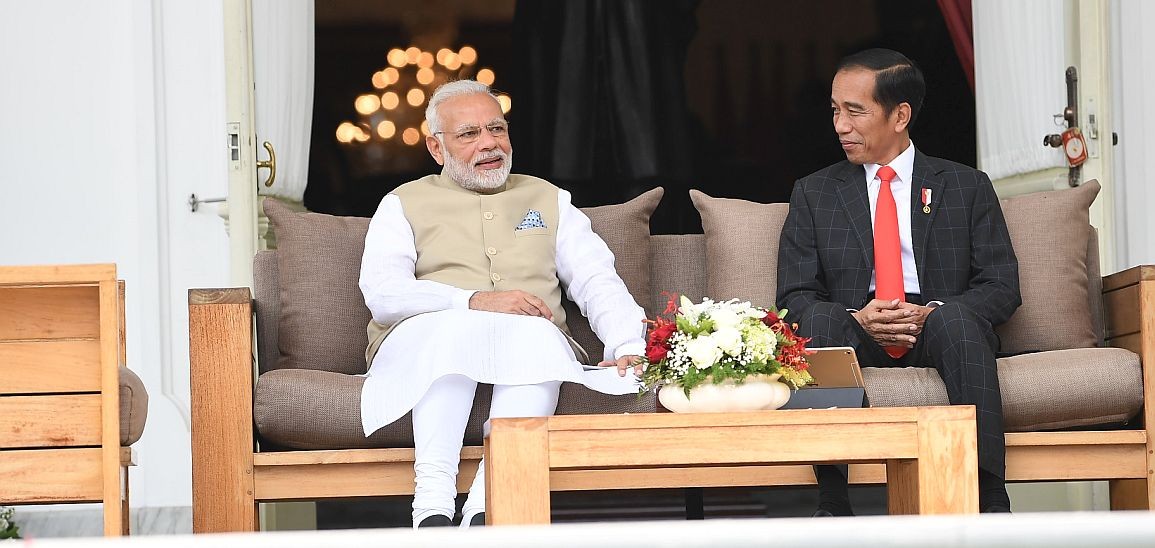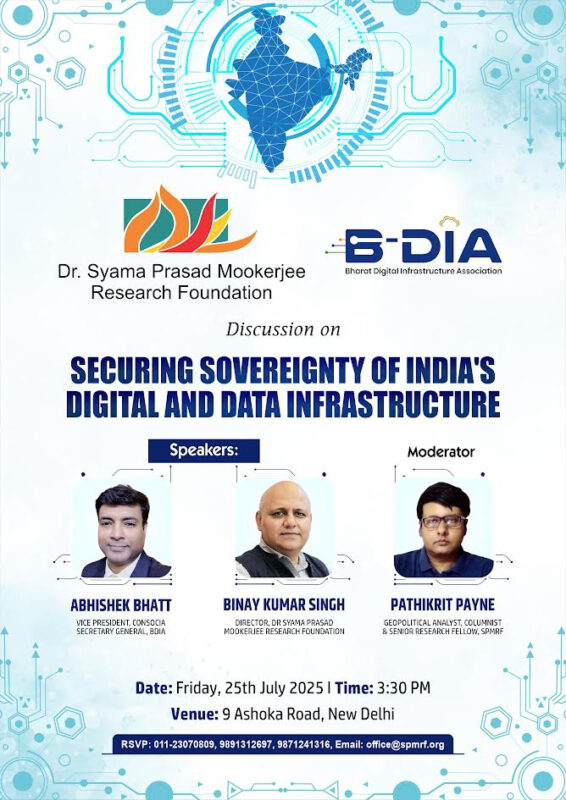To assess Prime Minister Modi’s visit to Indonesia in the last week of May this year, we have to find out first, the stakes India and Indonesia have in each other and the pull factor that brings them closer to each other. For India, Indonesia is a maritime neighbour. Indonesia’s Aceh in the northernmost tip of Sumatra is only 80 nautical miles from India’s Andaman &Nicobar Islandsand even closer than any part of India. With a coastline of 7,500 kms, with more than 1,380 islands and more than two million sq. km of Exclusive Economic Zone, India occupies a central position in the Indo-Pacific, while Indonesia as the largest archipelagic State in the world, with a coastline of 108,000 kms, with 17,504 islands and features and a total of maritime areas of 6,400,000 sq. km including Exclusive Economic Zone, is a fulcrum that connects the Indian Ocean and Pacific Ocean. The two oceans represent a combined maritime region which is important for global maritime trade and commerce. As a consequence, the two countries have a mutual stake in each other’s progress, prosperity, stability and territorial integrity; and, as pluralistic democracies and developing societies, we face similar challenges. Indonesia is not only the most populous country in the region, with the largest Muslim population in the world; it has also immense natural resources and a strategic location, for it controls all or part of the very major waterway between the Pacific and the Indian Ocean. More than half of the world’s shipping traverses these waterways.
Given their location and capabilities, India and Indonesia have a critical role to play as sentinels for vital sea-lanes. They also have a stake in shaping an emerging security architecture of Asia that is not dominated by any single country, important at a time when China’s recent assertiveness and muscle flexing in the South China Sea, through its artificial island building and militarization of those territories claimed by some other ASEAN states, is creating strategic uncertainty in the region. Foreign Minister Sushma Swaraj during her visit to Jakarta in early January this year has rightly said that Indonesia has an important role in the development and shaping of the security fabric of the region, adding that the country is one of the most diverse democracy and has a critical role to play in evolution of the new security architecture in the Indo-Pacific region.
Both Indonesia and India are not only multi-religious but also multi-cultural and face the challenge of integrating their diverse and plural societies from primordial loyalties to civic loyalties and creating a sense of citizenship within a democratic framework through state motto of ‘Bhineka Tunggal Eka’ and ‘Unity in Diversity’. While both Indonesia and India had been successful in maintaining social harmony and cohesion and build political stability for many years after they achieved their independence through trials and tribulations, in recent years they are facing the rise of primordial loyalties and identity politics that are posing a major threat to such social cohesion and harmony. In the case of Indonesia, there has been a creeping Islamization of the society and polity of the country. The inroads of Arab Wahhabi and Salafi variant of Islam into Southeast Asia and elsewhere have led to a growing assertiveness on the part of the fundamentalists. As yet, such fundamentalist elements have not occupied the mainstream in Indonesia and are still fringe groups, the danger of their occupying a major space cannot be underestimated.
Despite these mutual stakes, India-Indonesia relations did not fulfil its promises and potentialities until very recently. For one, Indonesia’s military doctrine and foreign policy until President Joko Widodo came into power focussed more on the Pacific and its three concentric circles. Indonesia’s foreign policy priorities was based on geographic proximity, with the inner circle encompassing ASEAN (seen as the cornerstone of Indonesian foreign policy), the second circle comprising major neighbouring countries in East Asia, the third circle the wider Asia Pacific region, with the outer perimeters being of diminishing importance. Thus the Asia Pacific was the focus of Indonesia’s foreign policy interests and strategic priorities until recently, while relations with countries and regions beyond were selective, on the basis of what they could offer Indonesia economically. As a corollary, the Indian Ocean did not find mention in Jakarta’s military doctrine. Ever since President Jokowi’s articulated his visionof Indonesia as a Global Maritime Fulcrum (GMF) in the Pacific and Indian Ocean region (or PACINDO), geographically much more extensive than the “Indo-Pacific” idea championed by Yudhoyono and his foreign minister Marty Natalegawa, New Delhi received much greater attention in Jakarta’s foreign policy. For another, economic interactions between the two countries, while it had improved in the recent past, are still quite insignificant to attract Jakarta for meaningful cooperation. However, there are two developments in recent years that had changed the contours of relations between the two countries—Jokowi’s vision of GMF and Indonesia’s uneasy relations with China over the Natuna Island in the South China Sea which belongs to the former but the latter’s Nine Dash Line touches a part of it, and had been a source of irritation.Indonesia renamed the northern reaches of its exclusive economic zone in the South China Sea as the North Natuna Sea in July 2017, an act of resistance by Southeast Asian nations to China’s territorial ambitions in the maritime region.
Jokowi’s vision of GMF and Modi’s ideas about Sagarmala with their emphasis on port and infrastructure development opened the ground for maritime cooperation in various aspects.The mostimportant aspect of Prime Minister Modi’s visit to Indonesia was the signing of a shared vision of the two countries on Maritime Cooperation in the Indo-Pacific, and reiterating the importance of achieving “a free, open, transparent, rules-based, peaceful, prosperous and inclusive Indo-Pacific region, where sovereignty and territorial integrity, international law, in particular UNCLOS, freedom of navigation and overflight, sustainable development and an open, free, fair and mutually beneficial trade and investment system are respected.”The other aspect is the elevation of bilateral relationship between the two countries to the level of Comprehensive Strategic Partnership and creation of new mechanisms like bilateral security dialogue, trilateral dialogue, signing of an enhanced Defense Cooperation Agreement and Framework Agreement on Cooperation in the Exploration and Uses of Outer Space for Peaceful Purposes.Indonesia has agreed to give India economic and military access to the strategic island of Sabang at the northern tip of Sumatra and close to the Malacca Strait, where New Delhi will invest in the port and economic zone of Sabang and build a hospital. Besides the development of the port, there is a possibility that Indian naval ships would be allowed to visit Sabang.
The two countries have also agreed joint production of equipment, technology transfer, technical assistance and capacity building as well as sourcing of defence equipment. Among other things New Delhi and Jakarta will enhance bilateral cooperation in countering terrorism, terrorist financing, money laundering, arms smuggling, trafficking in persons and cybercrime and intelligence cooperation.Finally, in managing diversity, Indonesia and India realizedthe importance of interfaith dialogue as an effective forum to nurture peace and social harmony, as well as to promote democracy and human rights. Interfaith dialogue or what can be called ‘civilizational dialogue’ – Samvad – helps to explore a new understanding on the rise of religious identities, the dynamic of pluralism and to eradicate radicalism, terrorism, and violent extremism. If the vision and the agreements can be translated into action, India and Indonesia can become the torch bearer of peace, progress and stability in the Indo-pacific region.
(The views expressed are the author's own and do not necessarily reflect the position of the organisation)


